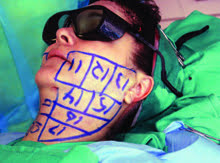High Patient Satisfaction With New Laser Facelift Procedure
During the laser facelift, energy was applied in grid pattern, with squares of the neck and lower face treated individually. This picture is of one 54-year-old female patient who was about to undergo the procedure.
A well-known cosmetic surgeon recently published a study that explains a new laser facelift technique.
As so many technological advancements change the field of cosmetic surgery, patients who desire a short recovery have an increasing number of options.
Lasers have been instrumental in the shift toward these procedures. They’ve been used to dramatically transform techniques in skin resurfacing, liposuction and incisions.
Just five years ago, Cynosure’s 1064-nm Nd:YAG laser received FDA approval for performing surgical incision, excision, vaporization, ablation, and coagulation of soft tissues. Since then, surgeons have continued to implement laser technology in new and interesting ways.
Dr. Patrick McMenamin, a facial plastic surgeon in Sacramento is performing a “laser facelift” procedure that he says can provide high patient satisfaction and short recovery time. He explains the procedure in a new issue of the journal Facial Plastic Surgery, comparing it to the traditional facelift that he also performs.
The laser facelift procedure was partly inspired by findings from surgeons on the east coast who found that dual wavelength laser lipolysis could provide significant improvements in skin elasticity. Rather than fat removal, Dr. McMenamin’s goal was to achieve facial skin contraction and tightening.
Between May 2008 and May 2010, 40 patients underwent a laser facelift in the doctor’s Sacramento office surgery suite. Patients had different needs, so their procedures were tailored accordingly, with some patients receiving a full facelift or neck lift.
During the surgery, laser energy was carefully applied to the patient’s face in a grid pattern, while a minimal amount of fatty tissue was removed.
Most patients were back to work within 7 days, compared to the 10-12 day recovery period Dr. McMenamin typically sees with his traditional facelift patients. They also showed high satisfaction. “Although numerical data are not available and the number of patients is small, these patients appear to have been more satisfied than those undergoing non-laser face-lifts in my practice,” the doctor writes.
So is the laser facelift superior to a traditional facelift? According to Dr. McMenamin, it is a better procedure for addressing certain conditions. “I can now get better results in the nasolabial fold area, the lower part of the lip, and the jowls,” he says, and “using this laser on the neck yields results that can be as good as those achieved by doing a traditional facelift.”
It also seems to be an excellent procedure for patients who are a) not yet ready for a full facelift, and b) would like a shorter recovery period. You can read the study abstract on Pubmed.



